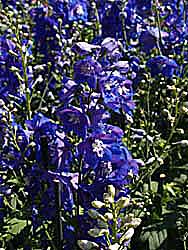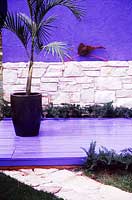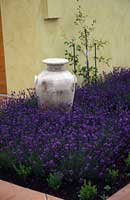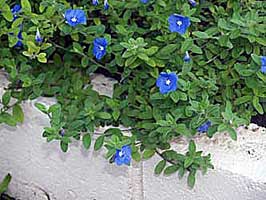Blue On Blue
Blue can be gentle and soothing or bold and brave – to make your garden complete go for the shades that suit you best.

When considering using colour in the garden, balance is the key. Nature provides balance through the colour green, which is present to some extent in nearly every plant and which enhances the colour of the flowers. Each colour stimulates feelings and emotions that we may or may not be aware of.
Choosing Blue
Blue is associated with peacefulness and tranquillity. Its relaxing ambience is also highlighted by its association with ice and coldness. Blue colours, as with any other colours, work best when planted alongside their opposites on the colour wheel or their neighbours. This means that blue works well when planted alongside reds and oranges or planted alongside mauve.
 Since winter is a time when many plants are dormant, and the season when we spend the least time in the garden, what could be more peaceful than peering out over a garden scene that encompasses blue flowers or foliage?
Since winter is a time when many plants are dormant, and the season when we spend the least time in the garden, what could be more peaceful than peering out over a garden scene that encompasses blue flowers or foliage?
Using Blue
Blue has been used traditionally to create ‘garden rooms’ or areas of the garden with an emphasis on repose. Many famous gardens have ‘blue borders’, notably the one at Sissinghurst in England. The idea was to build a deep garden bed with low planting in the foreground and progressively higher foliage in the background. All the plants used would have blue, violet or lilac flowers (and occasionally white), so as to be soothing on the eye and hence the soul. For example, French lavender (Lavandula dentata), grape hyacinth (Muscari sp.), Liriope sp., Dianella sp., Pansies (Viola cornuta sp.) and Scaevola sp., could all be used in the foreground. Taller plantings toward the rear might include Agapanthus sp., Iris sp., and Delphinium sp.. Blue-flowering or foliaged shrubs, trees, or climbers (if there is a suitable backdrop) could complete the scene.
‘Bee for Blue’
Birds are attracted to brightly coloured flowers such as reds and oranges. Bees are attracted to the blue-yellow area of the colour spectrum as they cannot see red.
Blue Foliage
Depending where you live, you may find it difficult to obtain plants that will produce blue flowers over winter. One way to overcome this is to look for bluish foliage plants most of which will be evergreen and thus retain their leaves over winter. The colour may be bluish-green (Metrosideros excelsus, New Zealand Christmas Bush), bluish-grey (Festuca ovina ‘Glauca’) or bluish-silver (Cedrus atlantica ‘Glauca’.). All of these colours will bring light to the garden. The pale blue-greys of some conifers and gum trees will also add an ethereal quality to the garden, suggesting distance and infinity as they mimic the colours of distant hills on the horizon.

Other Blues
You do not have to restrict your blue colour scheme to flowers and foliage. You can use natural elements of the landscape. For example, a blue sky, blue water. If your winter sky is mostly grey, then you can create other areas of blueness by incorporating blue furniture, trellis, pots, mosaics or a painted blue wall. Just don’t overdo it. Too much of any single colour can destroy the effect you are trying to achieve.
The Meaning of Blue
As well as being symbolic of calmness and coldness, blue is also associated with healing and creativity. Throughout history blue has been used significantly in the stained glass windows of churches. The blue stone, lapis lazuli, has also been used extensively to cover the ceilings of pyramids where it represented divinity.
Here are some suggestions for adding blue plants to your winter garden:
Blue Bulbs
 Iris (Dutch Iris) — Bulbs with fine green leaves and blue iris flowers with a yellow centre in late winter-early spring. (White, mauve and yellow forms also available.)
Iris (Dutch Iris) — Bulbs with fine green leaves and blue iris flowers with a yellow centre in late winter-early spring. (White, mauve and yellow forms also available.)
Blue Annuals
Myosotis sylvatica (Forget-me-not) — Annual with clusters of small blue flowers in late winter-early spring. Can become invasive in other parts of the garden.
Viola (Pansies) — Small annuals with highly attractive blue flowers (many coloured forms available).
Blue-Flowering Shrubs
Azalea — Medium sized shrubs with blue/mauve/purple colour varieties.
Hydrangea macrophylla — Shrub with broad green leaves and large rounded flower heads in summer. Acid soils produce the darker blue flowers (ranging to pink in alkaline soils).
Rhododendron ‘Blue Bell’ — Blue toned flower on long-lived shrub.
Blue Coloured Foliage
Agave attenuata ‘Nova 7' — Succulent plant with grey-blue hue foliage, very popular with landscape designers.
Eucalyptus gunnii (Cider Gum) — Highly ornamental gum, suited to cooler climates having grey-blue leaves.
Hebe glaucophylla — A dwarf compact plant with white flowers and pale blue-green leaves. It grows to 50cm and makes an ideal formal plant
Pimelea imbricata — A compact, erect shrub growing to around 0.5m, having pink or white spring flowers, and blue-grey leaves.
Senecio mandraliscae — A trailing succulent to 20cm high with cylindrical glaucous-blue leaves that are pointed at the ends. Produces clusters of white flowers.
Strelitzia reginae (Bird of Paradise) — these native Australian plants are truly ‘exotic’. They form large clumps up to 1m tall and produce spectacular bird-like flowers.
Bluish Conifers
 There are many conifers with bluish foliage, and many dwarf varieties available for the smaller garden or rockery. Conifers are suited much better to temperate climates, though some are suited to the subtropics.
There are many conifers with bluish foliage, and many dwarf varieties available for the smaller garden or rockery. Conifers are suited much better to temperate climates, though some are suited to the subtropics.
Abies procera ‘Glauca’ — A pyramidal shaped conifer to more than 5m tall, with attractive pale-blue foliage. It prefers a fertile, moist, well-drained, acid soil.
Cedrus atlantica ‘Glauca’ — Tall conifer to 35m or more with pale blue foliage. It is suited to large gardens and parks.
Chamaecyparis lawsonia ‘Allumni’ — Very attractive, narrow pyramid-shaped conifer to 10m or more, with pale blue foliage. It can be hedged.
Chamaecyparis lawsonia ‘Bleu Nantais’ — Dwarf form of the Lawson Cypress to 1.5m tall, with blue foliage.
Chamaecyparis obtusa ‘Sanderi’ — Compact, dense-foliaged conifer to 2m tall, with pale blue foliage. Outer foliage may turn purplish in very cold weather.
Cupressus glabra — Quick growing, columnar or pyramid-shaped tree to 20m tall. It has pale blue to bluish-green foliage. The cultivar ‘Glauca’ has even bluer foliage.
Juniperus virginiana ‘Sky Rocket’ — Attractive, tall, narrow conifer to 5m tall.
Picea pungens ‘Glauca’ — Large tree eventually reaching 30 m or more (generally less in cultivation), with pale blue foliage. It is suited only to very large gardens or parks. The cultivar P. pungens ‘Kosteri’ has the outer parts of branches pendulous.
Picea pungens ‘Globosa’ — Globe-shaped, dwarf cultivar of the Colorado spruce to 1m tall.
Picea pungens ‘Montgomery’ — Very attractive, cone-shaped shrub to 1.5 m tall with blue-silver foliage.
Want to Know More?
Consider doing a course or buying a reference book from our school.
If you would like to communicate with one of our professional tutors, consider using our free course counselling service. click for details
If you want to browse our bookshop, go to www.acsbookshop.com
 VISIT OUR ACS ONLINE E BOOKSTORE
VISIT OUR ACS ONLINE E BOOKSTORE
- Quality ebooks written by our staff
- Wide range of Horticulture titles by John Mason, author of over 40 gardening books, garden magazine editor, nurseryman, landscaper and principal of ACS.
- Ebooks can be purchased online and downloaded straight away.
- Read on an ipad, computer, iphone, reader or similar device.
- New titles published every month –bookmark and revisit this site regularly
- Download sample pages for free, to see what each book is like.
- Click here
Titles include:
Commercial Hydroponics 3rd edition
One of the worlds best selling hydroponic books, first published in 1991 by Kangaroo Press. Dozens of colour photos, unique and rarely published advice on how to grow over 100 different types of plants (vegetables, herbs, flowers, indoor plants) in hydroponics.
The Environment of Play 2nd edition
A unique and inspirational view of designing play spaces for children. Full of photos, an inspiration for parents, child care workers, teachers, play leaders, landscape designers and park management professionals. First edition was published in the 1980’s by Leisure Press in New York.
Growing Trees and Shrubs for Small Gardens 2nd edition
First edition published by Kangaroo Press/Simon & Schuster.
Tropical Plants 2nd edition
Trees and Shrubs for Warm Places First edition
A valuable reference for growing plants not only in the tropics and sub tropics, but also greenhouses, inside the home or even hot courtyards in a temperate garden. Never before been published. The book contains colour photos of close to 300 plants and descriptions of many times that number (and largely different to the plants covered in our Tropical Plants book).
Garden Design Part 1 1st edition
A huge book with around 300 inspiring colour photos; that explains how to design a garden in a way that is able to be understood by a beginner, but full of tips and ideas that can help even seasoned professionals.
Garden Design Part 2 1st edition
Following on from Garden Design Part 1, this presents approximately 300 more photos, and a huge amount of inspirational reading to help you (in particular), understand the different styles of garden and the options open to you as a garden designer, or a home owner.
Starting a Nursery or Herb Farm 3rd edition
Another best selling print book, now available as an e book. Previously published by Night Owl (first ed) and Simon and Schuster (2nd ed).
Starting a Garden or Landscape Business 2nd ed.
Previously published by Simon and Schuster; this is a must read for anyone wanting to set out on a career in horticulture.
Discounts offered for students of ACS Distance Education
More from ACS
Ebook - 117 pages of wonderful information, stunning pictures and great facts on lavenders.
View eBook
Ebook - Colourful informative book: covers all aspects of growing and using these lovely plants.
View eBook
Course - Start a lavender business: this course covers all the fundamentals needed.
View Course
Course - learn how to include range of lovely scented plants in gardens. Create a scented garden.
View Course
Enhance your design skills and apply them to various garden styles.
View Course
Ebook - informative guide: care, use selection and lots of coloured pics.
View eBook